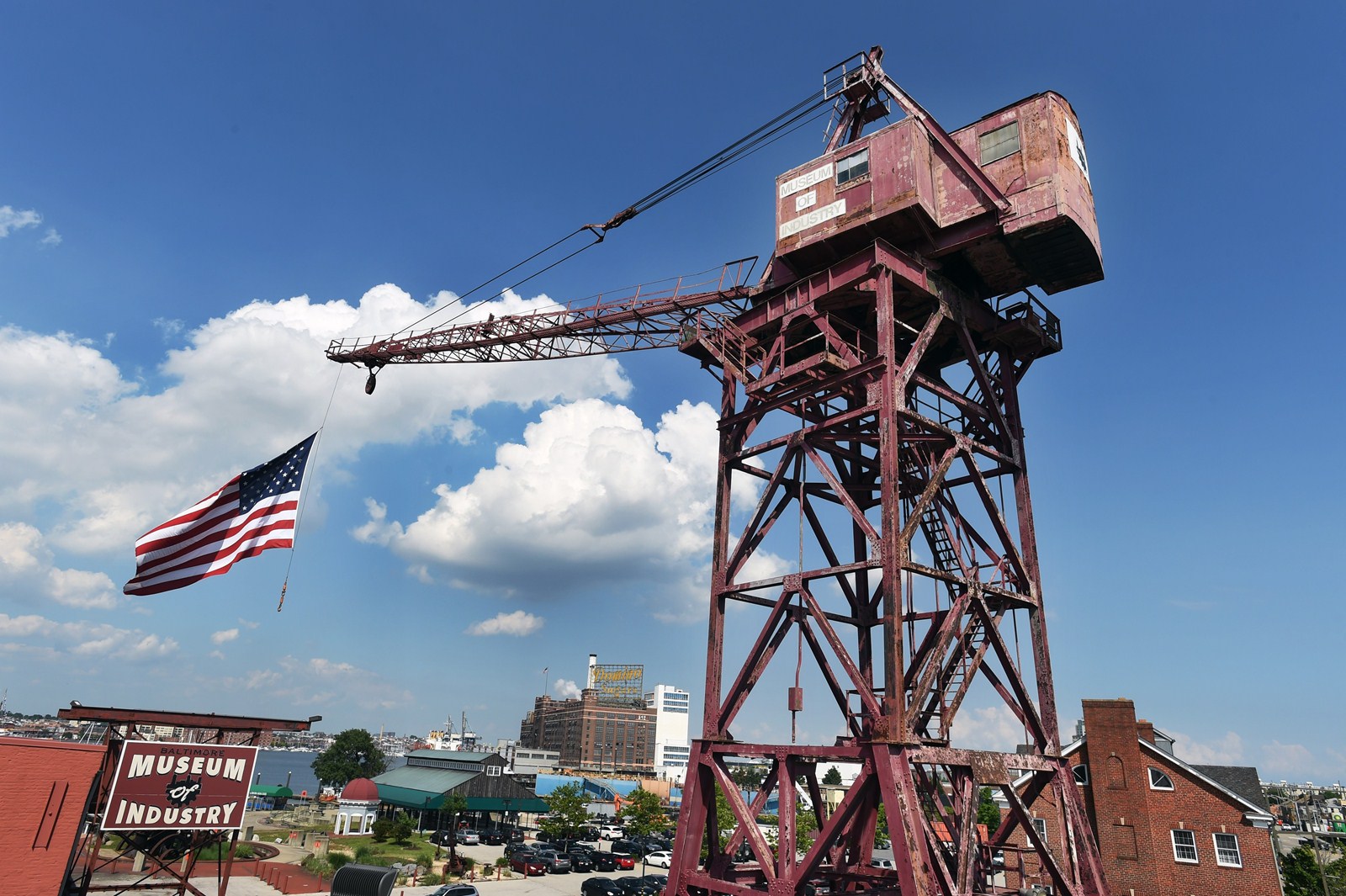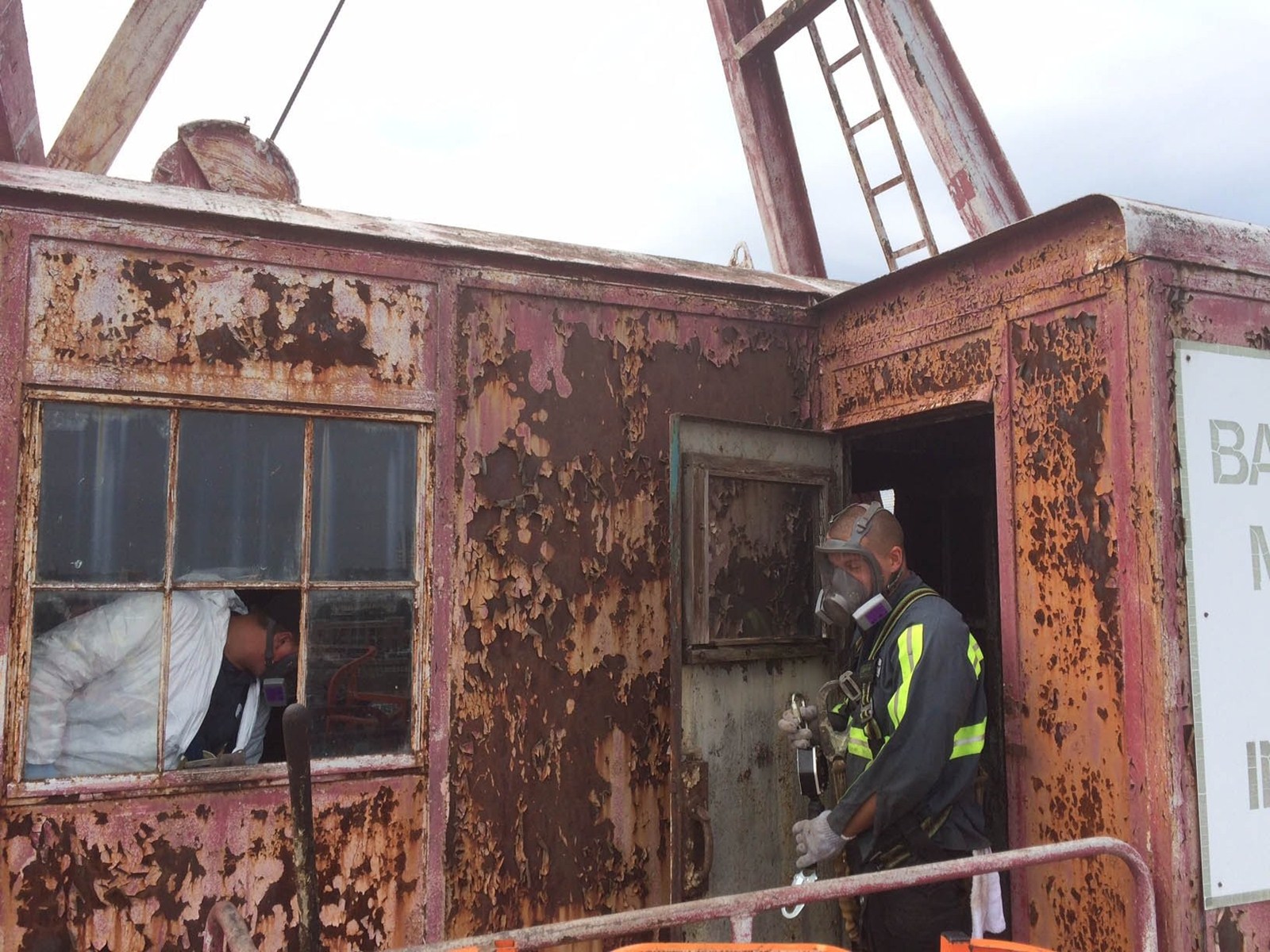Once-mighty shipyard crane to be repainted and restored
Baltimore Museum
of Industry launches
year-plus project


At some point or another, it became an unspoken routine.
Hilda and Ed Hawkins would park their Toyota Camry at the Baltimore Museum of Industry, where they lectured three days a week, and Hilda would get out and peer up at the World War II-era crane overlooking the parking lot.
“I know,” Ed told his wife. “Don't even say it.”
She hardly needed to: Anyone could see the crane badly needed maintenance. Its peeling burgundy paint was giving way to a grimy, brown-and-orange rust, and pigeons had long since laid claim to the operator's cab at the top, flying through an open window to nest.
Now the museum is raising money to restore the 100-foot-tall, 74-year-old crane. Officials say the project could take more than a year and cost as much as $500,000.
Renderings show the crane cleaned and repainted a sea-green color called “shipyard green” with yellow accents, and lit up in various colors at night. Museum executive director Anita Kassof said she hopes the crane will be “a landmark in this neighborhood.”
“This neighborhood is improving all the time, there are more and more people here, and I think they deserve something better than a crane which looks like it needs repair,” she said.
The first step? Evicting the birds — and cleaning out 25 years' worth of droppings.
Three workers from Ace Environmental in Curtis Bay donned HAZMAT suits and went up in a cherry-picker lift to spend five hours scraping, shoveling and disinfecting the inside of the cab. All told, they removed an estimated 500 pounds of guano.
“It had a pretty foul odor to it,” said Nick McDevitt, a field technician who lives in Glen Burnie.
Allan Cooper, an environmental supervisor from Pasadena, said the floor wasn't stable in some places. “You've got to watch your step,” he said.
The windows were re-sealed the next day to keep the pigeons from returning. An inspection, 3-D scan, engineered drawing and platform removal also concluded last month. The first phase of the project cost just under $25,000.
The next will involve putting up scaffolding, removing the boom, scraping the old paint and rust off the crane and repainting it — a $325,000 process that will begin when it's fully funded.
Museum officials then plan to spend $150,000 to outfit the crane with LED lights.
The museum has raised more than $12,000 in an
The project won a $15,000 grant from the Baltimore National Heritage Area, one of only eight competitive grants the nonprofit awarded this year, executive director Jeff Buchheit said.
The nonprofit has also funded repairs to the Carroll Mansion, the Patterson Park marble fountain and the front facade of St. Vincent de Paul church in Jonestown this year.
When Baltimoreans list the city's landmarks, Buchheit said, they generally name the usual suspects: the Bromo Seltzer tower, the shot tower and the Washington Monument, among others.
“I doubt currently that anybody would rattle off the crane as one of Baltimore's icons,” he said.
The 100-foot-tall Bethlehem Steel Clyde Model 17 DE 90 crane was built in 1942 by the Clyde Iron Works Company of Duluth, Minn. The model was called a “whirley crane” because it could turn 360 degrees.
For three years during World War II, it was part of an unprecedented shipbuilding effort.
Steelworkers used the crane and others like it at the Bethlehem Steel Fairfield Shipyard to build about one-sixth of the nation's Liberty cargo ships, and in record time.
By September 1943, the shipyard was building the ships in less than a month, and launching one every 35 hours, according to the Maryland Historical Society.
The shipyard's employment peaked at 46,700 workers, who flooded to Fairfield from all 48 states.
“On a number of occasions during the war,” the historians noted, “Bethlehem-Fairfield led all East Coast yards in production.”
When the Fairfield Shipyard closed at the end of the war in 1945, the crane was moved to Pier 3 of the Bethlehem Steel Key Highway Shipyard. It remained there for nearly 40 years, helping workers repair and convert warships into commercial vessels.
It was the last
It was disassembled and loaded onto barges for the trip down the harbor to the museum's parking lot, where it was painted and put back together at its current location, straddling the exit.
To select
“The current color scheme really blends in with all the red brick of the neighborhood,” Hoffman said. “We said, ‘Let's look back to history and get what the crane originally looked like.'?”
The inspiration for the lights came from the Titan Clydebank in Scotland and the Uljanik Shipyard in Croatia, he said. Both have become nighttime tourist attractions for their spectacular light displays.
Ashton Designs created
Hoffman said he sees similar potential in the crane.
“Old buildings having reinvented lives,” he said. “To see this crane have a reinvented life as well, it's a really nice parallel to what you see going on in the rest of the city.”
Michael Raphael, president of Direct Dimensions in Owings Mills, took a 3-D scan of the crane that can be printed to scale and used for surface area and other measurements.
Raphael compared the work, which his firm did free of charge, to a scan he did of the Washington Monument last year.
“These are monumental pieces with a high degree of exposure and importance,” he
John Pare is president of the Riverside Neighborhood Association.
“While there's all this growth occuring, it's important to maintain a lot of our historical landmarks,” Pare
Dan Goodier, whose company owns the building across Key Highway from the museum, said the timing is perfect to highlight Baltimore's historic attractions.
“We've had some tough national news lately,” he said. “Projects like this are really indicative of Baltimore becoming a world-class city while maintaining our rich heritage.”
Hilda Hawkins died three years ago. Ed Hawkins, still lecturing at the museum at 84, said he has donated $1,500 to the project in her memory, and plans to give more.
He said the crane is as significant to Baltimore and American history as Fort McHenry.
“When I give tours, I make it known about that crane,” he said.
After so many years of feeling helpless to do anything about his wife's pet peeve, he said, “I've got my chance.”
?



